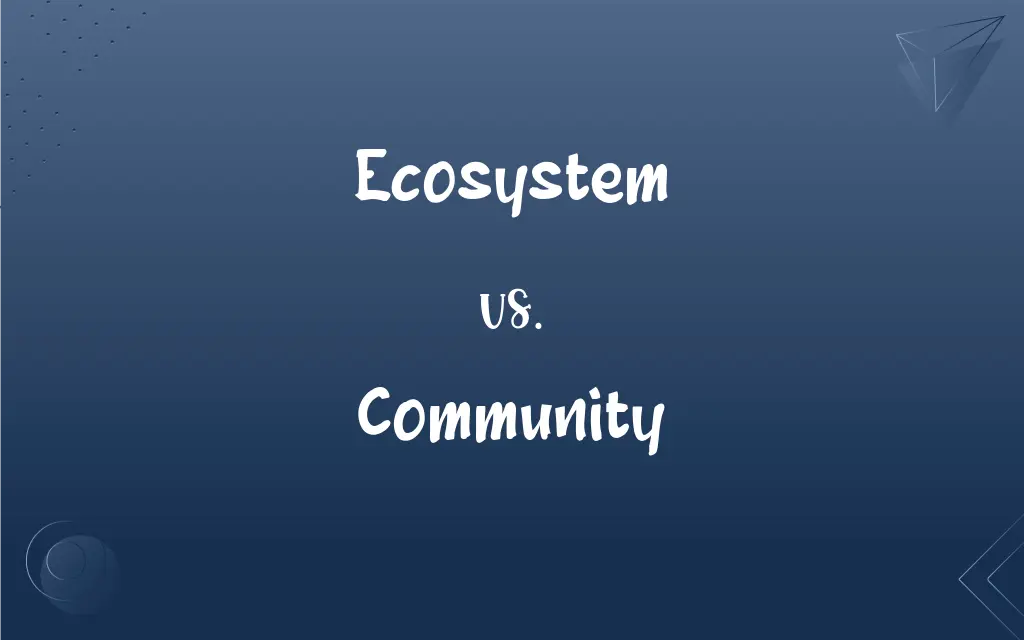Ecosystem vs. Community: What's the Difference?
Edited by Janet White || By Harlon Moss || Updated on October 24, 2023
An ecosystem comprises both living organisms and their physical environment, while a community consists only of interacting living organisms.

Key Differences
An ecosystem is a broader term that encompasses all biotic (living) and abiotic (non-living) components within a specific area, interacting in various ways. In contrast, a community is a subset of an ecosystem, referring solely to the collection of living organisms coexisting in a particular space.
Within an ecosystem, various factors like sunlight, water, soil, and temperature play significant roles. These factors influence the organisms but are not part of the community, which is strictly a biotic concept, only involving living entities.
The balance of an ecosystem relies on the intricate relationships between its living and non-living components. Meanwhile, the balance within a community revolves around predator-prey dynamics, competition, cooperation, and other interactions among its members.
Ecosystems can range from very small to vast expanses, such as a drop of water to an entire forest. A community, on the other hand, would represent only the living inhabitants of that drop of water or forest.
Studying an ecosystem entails examining energy flow, nutrient cycling, and both living and physical elements. Studying a community focuses on the relationships, interactions, and biodiversity of the living organisms present.
ADVERTISEMENT
Comparison Chart
Components
Includes biotic and abiotic factors
Only biotic factors (living organisms)
Interactions
Between living organisms and their physical environment
Among living organisms only
Scope
Broader, encompasses all elements in a particular area
Narrower, focusing only on the living entities
Study
Energy flow, nutrient cycling, physical and biological factors
Relationships, biodiversity, biotic interactions
Examples
Forest, pond, desert
Bird species in a forest, fish in a pond
ADVERTISEMENT
Ecosystem and Community Definitions
Ecosystem
A system formed by the interaction of living organisms with their physical environment.
The rainforest ecosystem is known for its rich biodiversity.
Community
A collection of living entities sharing an environment.
The community of a garden involves plants, insects, and birds.
Ecosystem
A community of living organisms in conjunction with their non-living surroundings.
Urban areas have their unique ecosystems influenced by human activities.
Community
An assemblage of different organisms living together in a particular habitat.
The lake community consists of aquatic plants, fish, and microorganisms.
Ecosystem
An interconnected and interdependent network of both living and non-living things.
The ecosystem of a pond includes fish, plants, water, and sunlight.
Community
Multiple species living together, often showing patterns of interaction.
Predation, competition, and mutualism shape the dynamics of a community.
Ecosystem
A dynamic complex where living organisms interact with each other and their physical environment.
Human actions can drastically impact the ecosystem, leading to imbalances.
Community
A group of living organisms coexisting and interacting in a specific environment.
The community in the coral reef includes various fish, coral species, and marine plants.
Ecosystem
A biological environment consisting of all organisms living in a particular area, plus all physical factors.
The desert ecosystem is characterized by its dryness and temperature extremes.
Community
All the populations of different species living and interacting in a particular place.
The forest community is diverse, from large mammals to tiny insects.
Ecosystem
An ecological community together with its environment, functioning as a unit.
Community
A group of people living in the same locality and under the same government.
Ecosystem
A system formed by an ecological community and its environment that functions as a unit.
Ecosystem
The interconnectedness of organisms (plants, animals, microbes) with each other and their environment.
Ecosystem
(by extension) A network of interconnected people or organisations that resembles a natural ecosystem due to the complex interdependencies.
The company’s ecosystem mainly comprises its supply chain, customers, end consumers and competitors.
Ecosystem
A system formed by the interaction of a community of organisms with their physical environment
FAQs
What comprises an ecosystem?
An ecosystem includes both living organisms and their physical environment.
How does energy flow in an ecosystem?
In an ecosystem, energy flows from producers to consumers to decomposers.
Can multiple communities exist within an ecosystem?
Yes, an ecosystem can house multiple communities.
What defines a community in ecological terms?
A community is an assemblage of interacting living organisms in a specific habitat.
How do community interactions contribute to ecosystem functions?
Community interactions, like predation and mutualism, shape the energy flow and nutrient cycling in an ecosystem.
How are food webs related to communities and ecosystems?
Food webs depict the feeding relationships within a community, which is a component of the larger ecosystem.
Can a man-made environment be an ecosystem?
Yes, a man-made environment can be an ecosystem with its own community of living organisms.
Are humans a part of the community?
Yes, humans are part of various communities within the global ecosystem.
How does biodiversity affect a community?
Greater biodiversity often leads to a more resilient and stable community within an ecosystem.
How does pollution affect ecosystems and communities?
Pollution can harm an ecosystem's physical components and disrupt the health and interactions of its community.
What role do decomposers play in ecosystems and communities?
Decomposers break down dead matter, recycling nutrients in both the ecosystem and supporting the community.
Can a single organism represent a community?
No, a community consists of multiple species interacting in an area.
Can ecosystems overlap?
Yes, ecosystems can overlap, leading to mixed communities.
What is the relationship between ecosystem health and community interactions?
Healthy ecosystem interactions often foster balanced and thriving communities.
Can a community change within a stable ecosystem?
Yes, community compositions can shift due to various factors even within a stable ecosystem.
Are all organisms in an ecosystem part of a single community?
No, an ecosystem can comprise multiple communities.
Can two communities have the same species composition?
Yes, two communities can have similar species, but their interactions and structures might differ based on the ecosystem.
What roles do abiotic factors play in an ecosystem?
In an ecosystem, abiotic factors like sunlight and soil influence the living community's growth and interactions.
What happens if an element of an ecosystem is disrupted?
Disruption in an ecosystem can impact its community and overall balance.
What's the difference between a marine ecosystem and a marine community?
A marine ecosystem includes living organisms and their physical oceanic environment, while a marine community refers only to the interacting marine organisms.
About Author
Written by
Harlon MossHarlon is a seasoned quality moderator and accomplished content writer for Difference Wiki. An alumnus of the prestigious University of California, he earned his degree in Computer Science. Leveraging his academic background, Harlon brings a meticulous and informed perspective to his work, ensuring content accuracy and excellence.
Edited by
Janet WhiteJanet White has been an esteemed writer and blogger for Difference Wiki. Holding a Master's degree in Science and Medical Journalism from the prestigious Boston University, she has consistently demonstrated her expertise and passion for her field. When she's not immersed in her work, Janet relishes her time exercising, delving into a good book, and cherishing moments with friends and family.































































